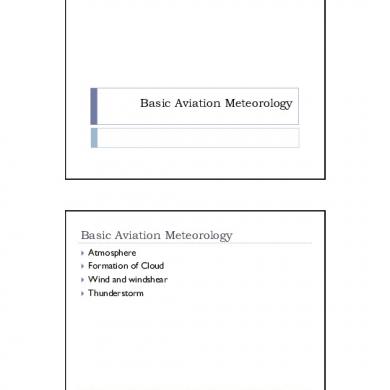Basic Aviation Meteorology
This document was uploaded by user and they confirmed that they have the permission to share it. If you are author or own the copyright of this book, please report to us by using this DMCA report form. Report DMCA
Overview
Download & View Basic Aviation Meteorology as PDF for free.
More details
- Words: 385
- Pages: 8
Loading documents preview...
5/20/2015
Basic Aviation Meteorology
Basic Aviation Meteorology Atmosphere Formation of Cloud Wind and windshear Thunderstorm
1
5/20/2015
Atmosphere Troposphere (7km-20km above surface) 99% of atmosphere water Most weather Higher altitude lower temperature
Tropopause (ceiling of Troposphere Most flight
Stratosphere (13km-50km above surface) Higher altitude higher temperature
Formation of Cloud Dew point – The temperature at which the water becomes saturated Associated with relative humidity (RH) When air is cooled to its dew point, water vapour condenses into droplets and forms cloud
2
5/20/2015
Formation of cloud Cloud base: height of cloud = (Ground temperature – dew point) x 400 Why cloud base? Formation of clouds: Orographic lift Advection Turbulence Convergence
Formation of cloud
Orographic lift
Advection (fog)
Turbulence Convergence
3
5/20/2015
Wind and Windshear Uneven heating of earth surface Different temperature, different rate Air rise – low pressure (air cool and condense) Air sink – high pressure Flow: High to low Wind
Wind and Windshear Lines joining points of equal sea-level pressure Coriolis force
isobars
Earth rotate anti-clockwise
Wind: vector of Pressure Gradient x Coriolis force
4
5/20/2015
Wind and Windshear Jet Stream Strong upper level winds Flow from West to East, stronger in Winter Japan 100-250 knots (Nautical mile/hr) HK-Vancouver shorter than reverse
Wind and Windshear Windshear Change of wind direction (head wind/tail wind) and/or speed Affect aircraft lift (and descend rate) May cause loss of control
5
5/20/2015
Wind and Windshear Common causes of windshear: Mountain wave Microburst Microburst: Intense localized cool air descends and spread onto the ground.
Diagram extracted from HKO website 2014
Wind and Wind shear Turbulence Rapid irregular motion of air Usually happen in clouds due to up and down movement of air mass Clear Air Turbulence (CAT) – dry therefore “Clear” or invisible Mountain wave Jet stream Weather radar impossible to detect
Source: SCMP http://www.scmp.com/news/hong-kong/article/1430508/eleveninjured-hong-kong-bound-cathay-flight-hit-turbulance-over?page=all
6
5/20/2015
Thunderstorm Contains nearly all weather hazards: Strong wind/ windshear/ turbulence Heavy rain (poor visibility) Lightning Severe icing Hails
Cause: 1. Unstable atmosphere (low pressure?) 2. Supply of moisture 3. Uplift of air mass
7
5/20/2015
Thunderstorm Uplift of air mass: Orographic lift Cold front
Phenomenon Towering cloud Cumulonimbus (Cb)
Avoid in all cases Safe to fly above? Near edge? Why Singapore no typhoon? QZ8501
Bibliography Aircraft General Knowledge, Navigation, Meteorology, Jeremy M Pratt, Airplane Flight Equipment Limited, 2003. ISBN: 9781874783183
8
Basic Aviation Meteorology
Basic Aviation Meteorology Atmosphere Formation of Cloud Wind and windshear Thunderstorm
1
5/20/2015
Atmosphere Troposphere (7km-20km above surface) 99% of atmosphere water Most weather Higher altitude lower temperature
Tropopause (ceiling of Troposphere Most flight
Stratosphere (13km-50km above surface) Higher altitude higher temperature
Formation of Cloud Dew point – The temperature at which the water becomes saturated Associated with relative humidity (RH) When air is cooled to its dew point, water vapour condenses into droplets and forms cloud
2
5/20/2015
Formation of cloud Cloud base: height of cloud = (Ground temperature – dew point) x 400 Why cloud base? Formation of clouds: Orographic lift Advection Turbulence Convergence
Formation of cloud
Orographic lift
Advection (fog)
Turbulence Convergence
3
5/20/2015
Wind and Windshear Uneven heating of earth surface Different temperature, different rate Air rise – low pressure (air cool and condense) Air sink – high pressure Flow: High to low Wind
Wind and Windshear Lines joining points of equal sea-level pressure Coriolis force
isobars
Earth rotate anti-clockwise
Wind: vector of Pressure Gradient x Coriolis force
4
5/20/2015
Wind and Windshear Jet Stream Strong upper level winds Flow from West to East, stronger in Winter Japan 100-250 knots (Nautical mile/hr) HK-Vancouver shorter than reverse
Wind and Windshear Windshear Change of wind direction (head wind/tail wind) and/or speed Affect aircraft lift (and descend rate) May cause loss of control
5
5/20/2015
Wind and Windshear Common causes of windshear: Mountain wave Microburst Microburst: Intense localized cool air descends and spread onto the ground.
Diagram extracted from HKO website 2014
Wind and Wind shear Turbulence Rapid irregular motion of air Usually happen in clouds due to up and down movement of air mass Clear Air Turbulence (CAT) – dry therefore “Clear” or invisible Mountain wave Jet stream Weather radar impossible to detect
Source: SCMP http://www.scmp.com/news/hong-kong/article/1430508/eleveninjured-hong-kong-bound-cathay-flight-hit-turbulance-over?page=all
6
5/20/2015
Thunderstorm Contains nearly all weather hazards: Strong wind/ windshear/ turbulence Heavy rain (poor visibility) Lightning Severe icing Hails
Cause: 1. Unstable atmosphere (low pressure?) 2. Supply of moisture 3. Uplift of air mass
7
5/20/2015
Thunderstorm Uplift of air mass: Orographic lift Cold front
Phenomenon Towering cloud Cumulonimbus (Cb)
Avoid in all cases Safe to fly above? Near edge? Why Singapore no typhoon? QZ8501
Bibliography Aircraft General Knowledge, Navigation, Meteorology, Jeremy M Pratt, Airplane Flight Equipment Limited, 2003. ISBN: 9781874783183
8
Related Documents

Basic Aviation Meteorology
March 2021 0
Meteorology
March 2021 0
Meteorology - I.c.joshi.pdf
March 2021 0
Synoptic Meteorology Textbook
March 2021 0
Aviation Networking
February 2021 0
Study Notes Weather Meteorology
March 2021 0More Documents from "Neeth"

Basic Aviation Meteorology
March 2021 0
Mathreviewworkbookgrade7.pdf
March 2021 0
Hwt - Transcripts With Notes 1.1 (tripp)
January 2021 1
Py Alpacas Patambuco
February 2021 0
Trading With Flag Patterns
January 2021 1